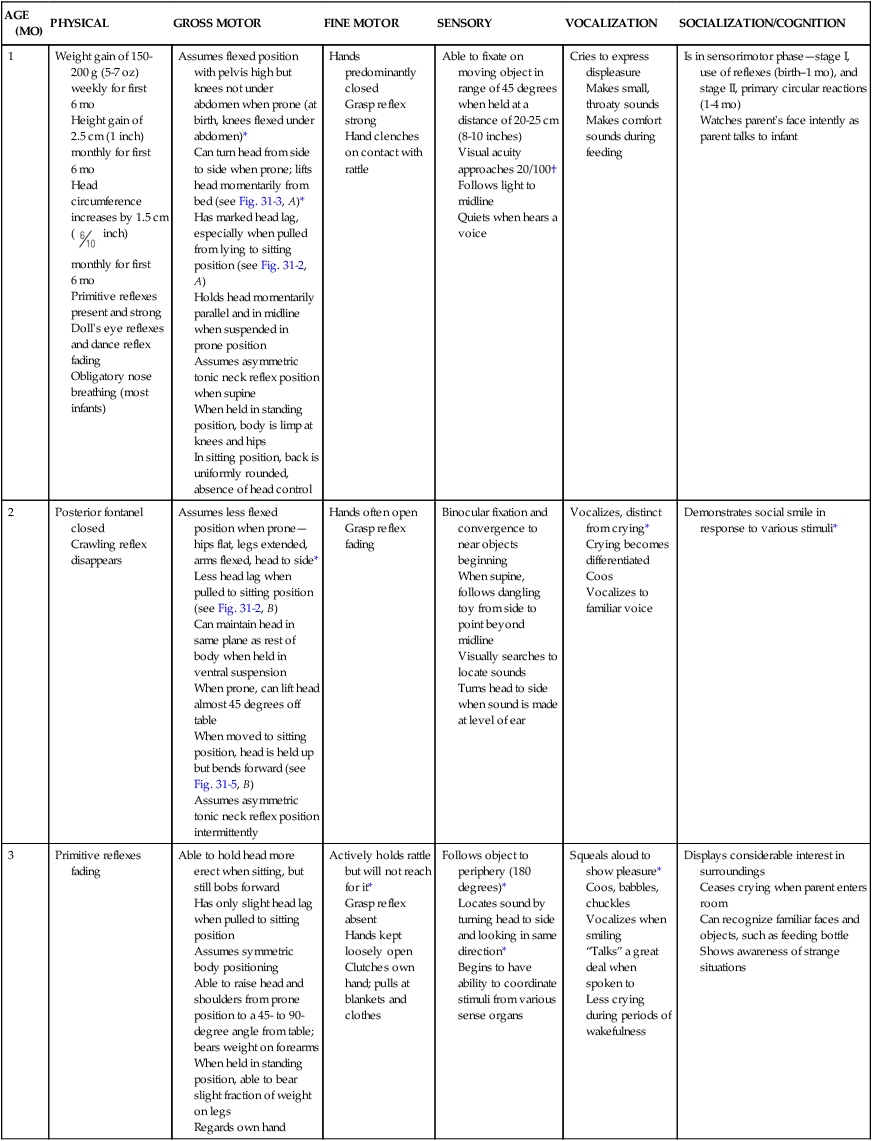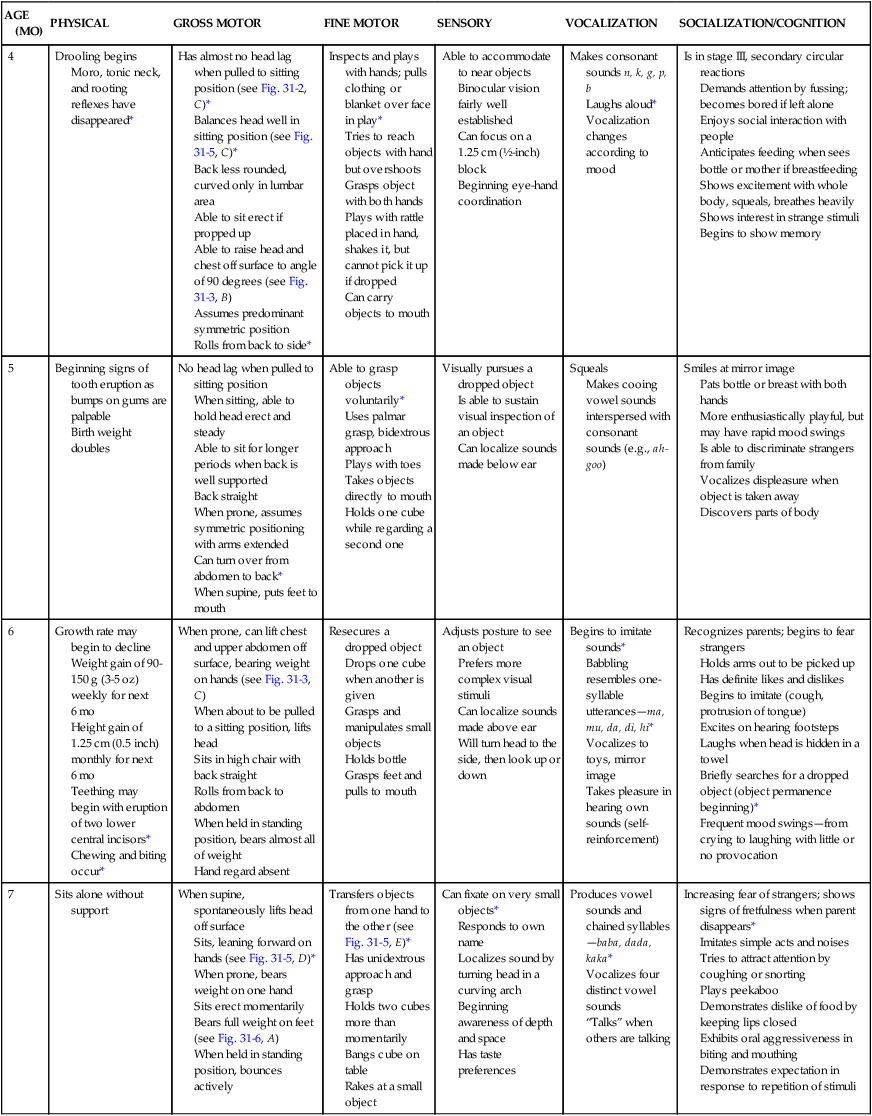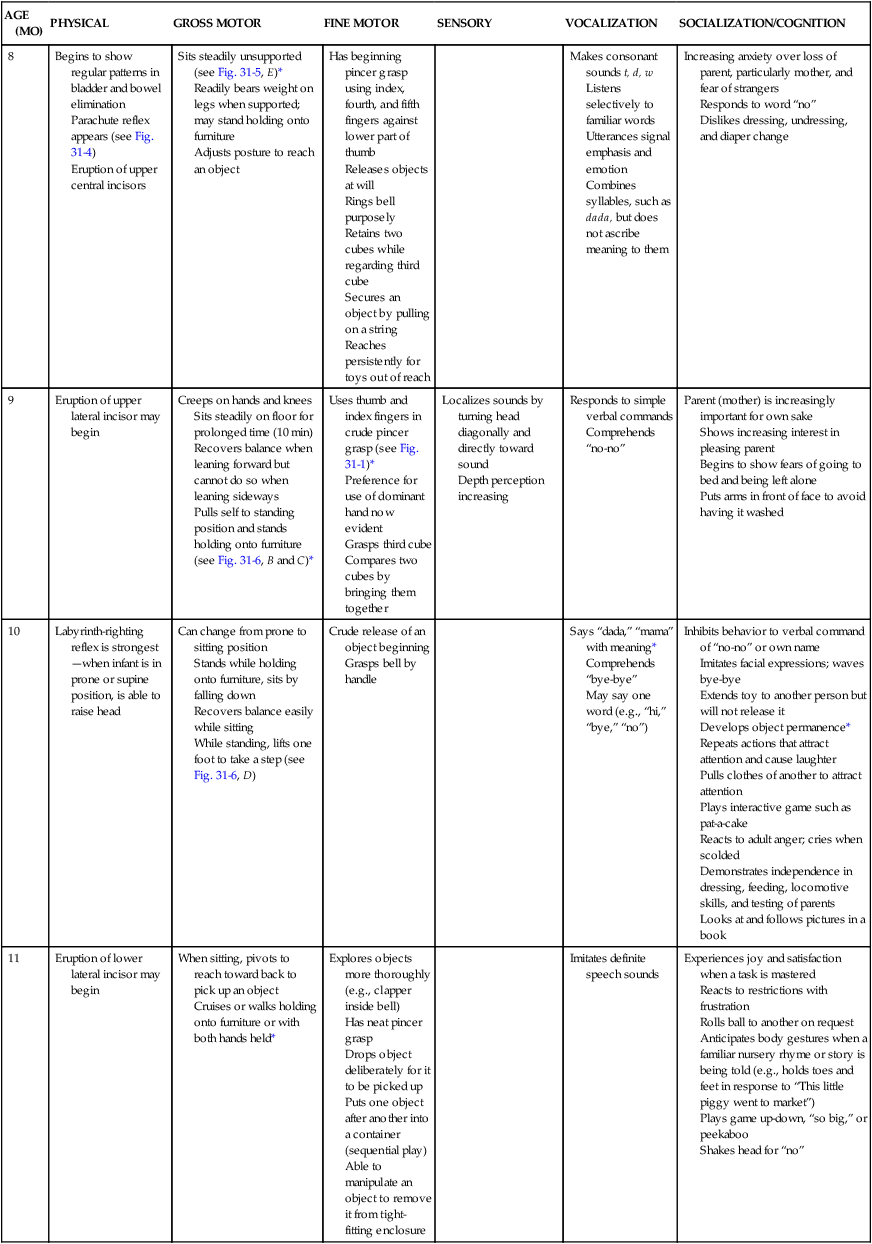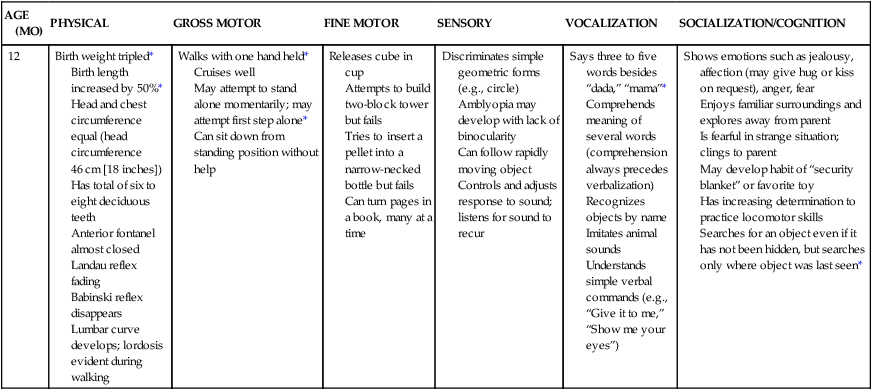Chapter 31 On completion of this chapter, the reader will be able to: • Identify the major biologic, psychosocial, cognitive, and social developments during the first year of life. • Relate parent-child attachment, separation anxiety, and stranger fear to developmental achievements during infancy. • Provide anticipatory guidance to parents regarding common parental concerns during infancy. • Provide anticipatory guidance to parents regarding recommendations for feeding infants. • Outline immunization requirements during infancy, early childhood, and adolescence. • List general contraindications, precautions, and administration routes for immunizations. • Provide anticipatory guidance to parents regarding injury prevention based on the infant’s developmental achievements. • Provide principles of anticipatory guidance in the care of the family with an infant who is experiencing colic. • Plan nursing care that meets the physical and emotional needs of the child and family with growth failure. • Provide nursing care that meets the immediate and long-term needs of the family who lost a child from sudden infant death syndrome. • Provide anticipatory guidance for the prevention of sudden infant death syndrome. • Identify the needs of the family whose child is home-monitored for apnea. Expanding head size reflects the growth and differentiation of the nervous system. By the end of the first year, the brain has increased in weight about 2.5 times. Maturation of the brain is exhibited in the dramatic developmental achievements of infancy (Table 31-1). Primitive reflexes are replaced by voluntary, purposeful movement, and new reflexes that influence motor development appear. TABLE 31-1 GROWTH AND DEVELOPMENT DURING INFANCY *Milestones that represent essential integrative aspects of development that lay the foundation for the achievement of more advanced skills. †Degree of visual acuity varies according to vision measurement procedure used. Because of the complexity of the developmental process during the first 12 months, Table 31-1 is presented to help organize and clarify the data already discussed. Although all milestones are important, some represent essential integrative aspects of development that lay the foundation for achievement of more advanced skills. These essential milestones are designated by an asterisk in the table. The table represents the average monthly age at which various skills are attained. It must be remembered that although the sequence is the same, the rate will vary among children. Other organ systems also change and grow during infancy. The respiratory rate slows somewhat (see Appendix C) and is relatively stable. Respiratory movements continue to be abdominal. Several factors predispose the infant to more severe and acute respiratory problems. The close proximity of the trachea to the bronchi and its branching structures rapidly transmits infectious agents from one anatomic location to another. The short, straight eustachian tube closely communicates with the ear, allowing infection to ascend from the pharynx to the middle ear. In addition, the inability of the immune system to produce sufficient immunoglobulin A (IgA) in the mucosal lining provides less protection against infection in infancy than during later childhood. The heart rate slows (see Appendix C), and the rhythm is often sinus dysrhythmia (i.e., rate increases with inspiration and decreases with expiration). Blood pressure also changes during infancy (see Appendix C). Systolic pressure rises during the first 2 months as a result of the increasing ability of the left ventricle to pump blood into the systemic circulation. Diastolic pressure decreases during the first 3 months and then gradually rises to values close to those at birth. Fluctuations in blood pressure occur during varying states of activity and emotion. Significant hematopoietic changes occur during the first year (see Appendix B). Fetal hemoglobin (HgbF) is present in large quantities for the first 5 months, with adult hemoglobin steadily increasing through the first half of infancy. Fetal hemoglobin has a shorter life span than adult hemoglobin; therefore there is an increased turnover of these cells and a gradual decrease in hemoglobin. This process results in a physiologic anemia around 3 to 6 months of age. High levels of HgbF depress the production of erythropoietin, a hormone released by the kidney that stimulates red blood cell production. Hemoglobin levels decrease to a certain point at which tissue oxygenation needs stimulate erythropoietin, and erythropoiesis resumes, forming new red blood cells. The immaturity of the digestive processes is evident in the appearance of stools. During infancy, solid foods (e.g., peas, carrots, corn, and raisins) are passed incompletely broken down in the feces. An excess quantity of fiber easily disposes the child to loose, bulky stools. During infancy, the stomach enlarges to accommodate a greater volume of food. By the end of the first year, the infant is able to tolerate three meals a day and an evening bottle and may have one or two bowel movements daily. With any type of gastric irritation, however, the infant is vulnerable to diarrhea, vomiting, and dehydration (see Chapter 41). Maturation of the suckling, sucking, and swallowing reflexes and the eruption of teeth (see Teething, p. 881) parallel the changes in the gastrointestinal tract and prepare the infant for the introduction of solid foods. Prebiotic oligosaccharides found in breast milk produce probiotic bacteria such bifidobacteria and lactobacilli, which in turn stimulate synthesis and secretion of secretory IgA (sIgA). Secretory IgA is present in large amounts in colostrum; IgA confers protection to the mucous membranes of the gastrointestinal tract (Blackburn, 2013; Lawrence and Lawrence, 2011) against many bacteria, such as Escherichia coli, and viruses, such as rubella, poliovirus, and the enteroviruses. The development of the mucosa-associated lymphoid tissue occurs during infancy; in part, this system is believed to prevent colonization and passage of bacteria across the infant’s mucosal barrier (Lawrence and Lawrence, 2011). The function and quantity of T-lymphocytes, lymphokines, interferon-γ, interleukins, tumor necrosis factor-α, and complement are reduced in early infancy, thus preventing optimal response to certain bacteria and viruses. The production of IgA and immunoglobulins D and E (IgD and IgE) is much more gradual, and maximum levels are not attained until early childhood. Probiotics may have a significant role in helping the gastrointestinal tract establish a “good” bacterial colonization in the gut to prevent many illnesses, including antibiotic-induced diarrhea and possibly Helicobacter pylori gastritis (Thomas, Greer, American Academy of Pediatrics [AAP], et al., 2010). There is evidence that vernix caseosa, a white oily substance that coats the term infant’s body and is often found in abundance in creases of the axilla and groin, has innate immunologic properties that serve to protect the newborn from infection (Narendran and Hoath, 2006). Vernix also appears to have a role in maintaining the integrity of the stratum corneum and facilitating acid mantle development (Hoath, Pickens, and Visscher, 2006). The epidermis of the full-term infant undergoes maturation during the first month of life; the newborn’s skin acts as a barrier to infection, assists in thermal regulation, and prevents transepidermal water loss in term infants. The immaturity of the renal structures also predisposes the infant to dehydration. Complete maturity of the kidney occurs during the latter half of the second year, when the cuboidal epithelium of the glomeruli becomes flattened. Before this time, the glomeruli’s filtration capacity is reduced. Urine is voided frequently and has a low specific gravity (i.e., 1.000 to 1.010). At term, most infants produce and excrete approximately 15 to 60 mL/kg/24 hr, and an output of less than 0.5 mL/kg/hr after 48 hours of age is considered to be oliguria (Blackburn, 2013).
The Infant and Family
Promoting Optimal Growth and Development
Biologic Development
Proportional Changes
AGE (MO)
PHYSICAL
GROSS MOTOR
FINE MOTOR
SENSORY
VOCALIZATION
SOCIALIZATION/COGNITION
1
Weight gain of 150-200 g (5-7 oz) weekly for first 6 mo
Height gain of 2.5 cm (1 inch) monthly for first 6 mo
Head circumference increases by 1.5 cm ( inch) monthly for first 6 mo
inch) monthly for first 6 mo
Primitive reflexes present and strong
Doll’s eye reflexes and dance reflex fading
Obligatory nose breathing (most infants)
Assumes flexed position with pelvis high but knees not under abdomen when prone (at birth, knees flexed under abdomen)*
Can turn head from side to side when prone; lifts head momentarily from bed (see Fig. 31-3, A)*
Has marked head lag, especially when pulled from lying to sitting position (see Fig. 31-2, A)
Holds head momentarily parallel and in midline when suspended in prone position
Assumes asymmetric tonic neck reflex position when supine
When held in standing position, body is limp at knees and hips
In sitting position, back is uniformly rounded, absence of head control
Hands predominantly closed
Grasp reflex strong
Hand clenches on contact with rattle
Able to fixate on moving object in range of 45 degrees when held at a distance of 20-25 cm (8-10 inches)
Visual acuity approaches 20/100†
Follows light to midline
Quiets when hears a voice
Cries to express displeasure
Makes small, throaty sounds
Makes comfort sounds during feeding
Is in sensorimotor phase—stage I, use of reflexes (birth–1 mo), and stage II, primary circular reactions (1-4 mo)
Watches parent’s face intently as parent talks to infant
2
Posterior fontanel closed
Crawling reflex disappears
Assumes less flexed position when prone—hips flat, legs extended, arms flexed, head to side*
Less head lag when pulled to sitting position (see Fig. 31-2, B)
Can maintain head in same plane as rest of body when held in ventral suspension
When prone, can lift head almost 45 degrees off table
When moved to sitting position, head is held up but bends forward (see Fig. 31-5, B)
Assumes asymmetric tonic neck reflex position intermittently
Hands often open
Grasp reflex fading
Binocular fixation and convergence to near objects beginning
When supine, follows dangling toy from side to point beyond midline
Visually searches to locate sounds
Turns head to side when sound is made at level of ear
Vocalizes, distinct from crying*
Crying becomes differentiated
Coos
Vocalizes to familiar voice
Demonstrates social smile in response to various stimuli*
3
Primitive reflexes fading
Able to hold head more erect when sitting, but still bobs forward
Has only slight head lag when pulled to sitting position
Assumes symmetric body positioning
Able to raise head and shoulders from prone position to a 45- to 90-degree angle from table; bears weight on forearms
When held in standing position, able to bear slight fraction of weight on legs
Regards own hand
Actively holds rattle but will not reach for it*
Grasp reflex absent
Hands kept loosely open
Clutches own hand; pulls at blankets and clothes
Follows object to periphery (180 degrees)*
Locates sound by turning head to side and looking in same direction*
Begins to have ability to coordinate stimuli from various sense organs
Squeals aloud to show pleasure*
Coos, babbles, chuckles
Vocalizes when smiling
“Talks” a great deal when spoken to
Less crying during periods of wakefulness
Displays considerable interest in surroundings
Ceases crying when parent enters room
Can recognize familiar faces and objects, such as feeding bottle
Shows awareness of strange situations
4
Drooling begins
Moro, tonic neck, and rooting reflexes have disappeared*
Has almost no head lag when pulled to sitting position (see Fig. 31-2, C)*
Balances head well in sitting position (see Fig. 31-5, C)*
Back less rounded, curved only in lumbar area
Able to sit erect if propped up
Able to raise head and chest off surface to angle of 90 degrees (see Fig. 31-3, B)
Assumes predominant symmetric position
Rolls from back to side*
Inspects and plays with hands; pulls clothing or blanket over face in play*
Tries to reach objects with hand but overshoots
Grasps object with both hands
Plays with rattle placed in hand, shakes it, but cannot pick it up if dropped
Can carry objects to mouth
Able to accommodate to near objects
Binocular vision fairly well established
Can focus on a 1.25 cm (½-inch) block
Beginning eye-hand coordination
Makes consonant sounds n, k, g, p, b
Laughs aloud*
Vocalization changes according to mood
Is in stage III, secondary circular reactions
Demands attention by fussing; becomes bored if left alone
Enjoys social interaction with people
Anticipates feeding when sees bottle or mother if breastfeeding
Shows excitement with whole body, squeals, breathes heavily
Shows interest in strange stimuli
Begins to show memory
5
Beginning signs of tooth eruption as bumps on gums are palpable
Birth weight doubles
No head lag when pulled to sitting position
When sitting, able to hold head erect and steady
Able to sit for longer periods when back is well supported
Back straight
When prone, assumes symmetric positioning with arms extended
Can turn over from abdomen to back*
When supine, puts feet to mouth
Able to grasp objects voluntarily*
Uses palmar grasp, bidextrous approach
Plays with toes
Takes objects directly to mouth
Holds one cube while regarding a second one
Visually pursues a dropped object
Is able to sustain visual inspection of an object
Can localize sounds made below ear
Squeals
Makes cooing vowel sounds interspersed with consonant sounds (e.g., ah-goo)
Smiles at mirror image
Pats bottle or breast with both hands
More enthusiastically playful, but may have rapid mood swings
Is able to discriminate strangers from family
Vocalizes displeasure when object is taken away
Discovers parts of body
6
Growth rate may begin to decline
Weight gain of 90-150 g (3-5 oz) weekly for next 6 mo
Height gain of 1.25 cm (0.5 inch) monthly for next 6 mo
Teething may begin with eruption of two lower central incisors*
Chewing and biting occur*
When prone, can lift chest and upper abdomen off surface, bearing weight on hands (see Fig. 31-3, C)
When about to be pulled to a sitting position, lifts head
Sits in high chair with back straight
Rolls from back to abdomen
When held in standing position, bears almost all of weight
Hand regard absent
Resecures a dropped object
Drops one cube when another is given
Grasps and manipulates small objects
Holds bottle
Grasps feet and pulls to mouth
Adjusts posture to see an object
Prefers more complex visual stimuli
Can localize sounds made above ear
Will turn head to the side, then look up or down
Begins to imitate sounds*
Babbling resembles one-syllable utterances—ma, mu, da, di, hi*
Vocalizes to toys, mirror image
Takes pleasure in hearing own sounds (self-reinforcement)
Recognizes parents; begins to fear strangers
Holds arms out to be picked up
Has definite likes and dislikes
Begins to imitate (cough, protrusion of tongue)
Excites on hearing footsteps
Laughs when head is hidden in a towel
Briefly searches for a dropped object (object permanence beginning)*
Frequent mood swings—from crying to laughing with little or no provocation
7
Sits alone without support
When supine, spontaneously lifts head off surface
Sits, leaning forward on hands (see Fig. 31-5, D)*
When prone, bears weight on one hand
Sits erect momentarily
Bears full weight on feet (see Fig. 31-6, A)
When held in standing position, bounces actively
Transfers objects from one hand to the other (see Fig. 31-5, E)*
Has unidextrous approach and grasp
Holds two cubes more than momentarily
Bangs cube on table
Rakes at a small object
Can fixate on very small objects*
Responds to own name
Localizes sound by turning head in a curving arch
Beginning awareness of depth and space
Has taste preferences
Produces vowel sounds and chained syllables—baba, dada, kaka*
Vocalizes four distinct vowel sounds
“Talks” when others are talking
Increasing fear of strangers; shows signs of fretfulness when parent disappears*
Imitates simple acts and noises
Tries to attract attention by coughing or snorting
Plays peekaboo
Demonstrates dislike of food by keeping lips closed
Exhibits oral aggressiveness in biting and mouthing
Demonstrates expectation in response to repetition of stimuli
8
Begins to show regular patterns in bladder and bowel elimination
Parachute reflex appears (see Fig. 31-4)
Eruption of upper central incisors
Sits steadily unsupported (see Fig. 31-5, E)*
Readily bears weight on legs when supported; may stand holding onto furniture
Adjusts posture to reach an object
Has beginning pincer grasp using index, fourth, and fifth fingers against lower part of thumb
Releases objects at will
Rings bell purposely
Retains two cubes while regarding third cube
Secures an object by pulling on a string
Reaches persistently for toys out of reach
Makes consonant sounds t, d, w
Listens selectively to familiar words
Utterances signal emphasis and emotion
Combines syllables, such as dada, but does not ascribe meaning to them
Increasing anxiety over loss of parent, particularly mother, and fear of strangers
Responds to word “no”
Dislikes dressing, undressing, and diaper change
9
Eruption of upper lateral incisor may begin
Creeps on hands and knees
Sits steadily on floor for prolonged time (10 min)
Recovers balance when leaning forward but cannot do so when leaning sideways
Pulls self to standing position and stands holding onto furniture (see Fig. 31-6, B and C)*
Uses thumb and index fingers in crude pincer grasp (see Fig. 31-1)*
Preference for use of dominant hand now evident
Grasps third cube
Compares two cubes by bringing them together
Localizes sounds by turning head diagonally and directly toward sound
Depth perception increasing
Responds to simple verbal commands
Comprehends “no-no”
Parent (mother) is increasingly important for own sake
Shows increasing interest in pleasing parent
Begins to show fears of going to bed and being left alone
Puts arms in front of face to avoid having it washed
10
Labyrinth-righting reflex is strongest—when infant is in prone or supine position, is able to raise head
Can change from prone to sitting position
Stands while holding onto furniture, sits by falling down
Recovers balance easily while sitting
While standing, lifts one foot to take a step (see Fig. 31-6, D)
Crude release of an object beginning
Grasps bell by handle
Says “dada,” “mama” with meaning*
Comprehends “bye-bye”
May say one word (e.g., “hi,” “bye,” “no”)
Inhibits behavior to verbal command of “no-no” or own name
Imitates facial expressions; waves bye-bye
Extends toy to another person but will not release it
Develops object permanence*
Repeats actions that attract attention and cause laughter
Pulls clothes of another to attract attention
Plays interactive game such as pat-a-cake
Reacts to adult anger; cries when scolded
Demonstrates independence in dressing, feeding, locomotive skills, and testing of parents
Looks at and follows pictures in a book
11
Eruption of lower lateral incisor may begin
When sitting, pivots to reach toward back to pick up an object
Cruises or walks holding onto furniture or with both hands held*
Explores objects more thoroughly (e.g., clapper inside bell)
Has neat pincer grasp
Drops object deliberately for it to be picked up
Puts one object after another into a container (sequential play)
Able to manipulate an object to remove it from tight-fitting enclosure
Imitates definite speech sounds
Experiences joy and satisfaction when a task is mastered
Reacts to restrictions with frustration
Rolls ball to another on request
Anticipates body gestures when a familiar nursery rhyme or story is being told (e.g., holds toes and feet in response to “This little piggy went to market”)
Plays game up-down, “so big,” or peekaboo
Shakes head for “no”
12
Birth weight tripled*
Birth length increased by 50%*
Head and chest circumference equal (head circumference 46 cm [18 inches])
Has total of six to eight deciduous teeth
Anterior fontanel almost closed
Landau reflex fading
Babinski reflex disappears
Lumbar curve develops; lordosis evident during walking
Walks with one hand held*
Cruises well
May attempt to stand alone momentarily; may attempt first step alone*
Can sit down from standing position without help
Releases cube in cup
Attempts to build two-block tower but fails
Tries to insert a pellet into a narrow-necked bottle but fails
Can turn pages in a book, many at a time
Discriminates simple geometric forms (e.g., circle)
Amblyopia may develop with lack of binocularity
Can follow rapidly moving object
Controls and adjusts response to sound; listens for sound to recur
Says three to five words besides “dada,” “mama”*
Comprehends meaning of several words (comprehension always precedes verbalization)
Recognizes objects by name
Imitates animal sounds
Understands simple verbal commands (e.g., “Give it to me,” “Show me your eyes”)
Shows emotions such as jealousy, affection (may give hug or kiss on request), anger, fear
Enjoys familiar surroundings and explores away from parent
Is fearful in strange situation; clings to parent
May develop habit of “security blanket” or favorite toy
Has increasing determination to practice locomotor skills
Searches for an object even if it has not been hidden, but searches only where object was last seen*




Maturation of Systems
![]()
Stay updated, free articles. Join our Telegram channel

Full access? Get Clinical Tree


Nurse Key
Fastest Nurse Insight Engine
Get Clinical Tree app for offline access
